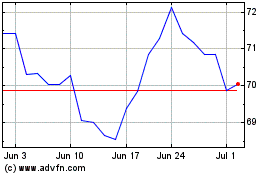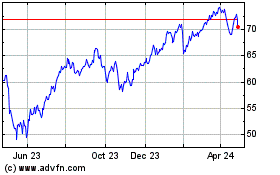By Leslie Scism
MetLife Inc. President and Chief Executive Steven Kandarian is
turning over the reins of the nation's second-biggest life insurer
by assets to a top lieutenant, Michel Khalaf, as he sets April 30
for his retirement.
Mr. Khalaf won't take Mr. Kandarian's chairman title, however.
In another development, MetLife said it is creating the position of
nonexecutive chairman, and the post will be held by its current
independent lead director, Glenn Hubbard, dean of the Graduate
School of Business at Columbia University.
MetLife had signaled the potential promotion of Mr. Khalaf in
June 2017 when he was named president of MetLife's core U.S.
business, while retaining his role as president of the company's
European, Middle East and African operations. The promotion gave
Mr. Khalaf significant additional responsibilities and distanced
him from other internal candidates.
Mr. Khalaf, 54 years old, joined MetLife in 2010 through the New
York company's acquisition of an international life-insurance
business from American International Group Inc. In his 21 years at
the AIG unit, he held senior roles around the world, with
responsibilities in places including the Caribbean, France, Italy,
Egypt, Poland, Romania and the Philippines.
Mr. Kandarian, who turns 67 in March, has been president and CEO
since May 2011 and added the title of chairman in January 2012. He
joined MetLife in 2005 as its investment chief.
"In Michel, we are fortunate to have a leader who has excelled
across a wide range of markets, businesses and cultures," Mr.
Hubbard said in prepared remarks. Mr. Hubbard is slated to step
down as dean at Columbia June 30.
As Mr. Khalaf took on the extra MetLife duties over the past 18
months, Mr. Kandarian was already beyond the company's customary
retirement age of 65. MetLife's board waived its age policy
indefinitely in 2016 in a strong show of support for the executive
at a critical juncture for the company.
At the time, Mr. Kandarian was divesting a large piece of the
company's traditional life-insurance unit, a move that hived off
its historic core: selling life insurance and other financial
products to individuals and families across the U.S.
Mr. Kandarian also was suing the U.S. government. He was
challenging in federal court MetLife's federal designation as a
"systemically important financial institution," which made it
subject to heightened oversight from the Federal Reserve on top of
state insurance-department oversight. His challenge ultimately was
successful.
Wells Fargo Securities analyst Elyse Greenspan said in a note
that an internal successor was expected because MetLife "has
historically promoted from within for top positions." She said the
timing seems right because the company had begun to post clean,
straightforward quarterly earnings again after the disruption tied
to the Brighthouse spinoff. She expects the change "to be
seamless."
Another analyst, Thomas Gallagher of Evercore ISI, said that Mr.
Khalaf's career has mostly been "in smaller international insurance
markets." Still, "while there may be some questions regarding Mr.
Khalaf's more limited time spent managing MET's flagship U.S.
operations, his expertise in several international markets should
help MET's future growth strategy outside of the U.S."
Mr. Gallagher said the four-month transition period is shorter
than he expected, especially considering that MetLife has a
relatively newly appointed chief financial officer.
The 150-year-old company Mr. Khalaf will take over is a leader
in sales of life, dental and other types of insurance sold to
employers, and it also offers pension and other retirement
products. It has roughly 49,000 employees globally and provides
products and services in about 40 countries. Outside the U.S., its
largest markets include Chile, Japan, Korea and Mexico.
In hiving off about a quarter of its assets in 2017 to create
the company now known as Brighthouse Financial Inc., MetLife lost
bragging rights as the biggest U.S. life insurer to Prudential
Financial Inc. MetLife now clocks in at about $700 billion in total
assets and remains bigger by market capitalization.
Mr. Kandarian's tenure has been bumpy at times. Low U.S.
interest rates relative to historical levels have pinched the
yields on invested premiums. Those low rates, along with high
capital requirements, played into the decision to set up
Brighthouse.
The company hit a rough patch in late 2017. Soon after Mr.
Khalaf began overseeing the U.S. operations, he learned that
MetLife's retirement-income-services unit years ago had failed to
adequately search for about 13,500 beneficiaries of private-sector
pension plans for which the company had taken on
responsibility.
Instead, it designated the people as "permanently unresponsive"
after a couple of unanswered letters and booked as profit the money
that should have been paid out. Some retirees were owed money from
as far back as the 1990s, with amounts averaging less than $150 a
month.
Mr. Kandarian publicly apologized about the pension-payments
mistake. In December, MetLife agreed to pay a $1 million fine to
Massachusetts tied to beneficiaries in its state. Probes including
an investigation by the Securities and Exchange Commission are
continuing.
Write to Leslie Scism at leslie.scism@wsj.com
(END) Dow Jones Newswires
January 08, 2019 11:53 ET (16:53 GMT)
Copyright (c) 2019 Dow Jones & Company, Inc.
MetLife (NYSE:MET)
Historical Stock Chart
From Mar 2024 to Apr 2024

MetLife (NYSE:MET)
Historical Stock Chart
From Apr 2023 to Apr 2024
